High Noon: Belka MW shootout part 2, with a review of the AFA200C active MW ferrite antenna
by 13dka
When I reviewed the updated Belka (gen3, 2022) for its MW/LW performance in October last year, I just wanted to know if it’s any good with just the whip antenna and used the XHDATA D-808 as a reference radio because it’s a Jay Allen 2.5-star average performer on MW and my expectations were not high for MW reception on a short whip. To my surprise that average bar turned out way too low for the Belka!
That was sure asking for a comparison with the most sensitive MW radio I have and gave me hope to use the Belka for ultra-portable MW DXing on the move. The omnidirectional whip doesn’t allow me to null out unwanted co-channel interference though, therefore I wanted to find a reasonably sized loopstick antenna to pair with the Belka.
Rare as hen’s teeth: small, portable loopstick antennas
My first idea was – of course – the C.Crane “Twin Coil Ferrite AM Antenna Signal Booster”, recently reviewed by Jock Elliott. Not as portable as I hoped for but I figured it might give the Belka a performance comparable to the CCRadio 2E with its similar antenna. But it wasn’t available on Amazon.com and the C.Crane shop told me they don’t ship to the EU and to try it on Amazon. I also failed at getting my questions answered by “BAZ Spezialantennen” and there’s also Grahn and Reuter (all in Germany) making ferrite antennas, but they’re all relying on pretty bulky tuner/amplifier boxes and cost up to 850€. Not quite what I had in mind.
The AFA200C by SV2CZF
Short of buying the 700€ super-high-tech active ferrite bar antenna off Reuter Elektronik , I found a Greek shop offering an antenna that looked like it was (almost) made for the Belka, costing little more than 1/10th of the Reuter: The AFA200C by SV2CZF is an active, tuned (0.5-2.5 MHz) 200mm loopstick antenna with a male BNC plug to attach the Belka directly to the antenna. The AFA200 is also available in 2 other versions, the -B model working from 1.5 to 7.5 MHz and the -D model receiving 3.5-18 Mhz. This is not only portable, it could turn the Belka into a wearable MW DX rig!
Not that it didn’t have some ordering boo boos of its own (see further down) but the format is right, it still works out of the breast-pocket and the not very hot output level of the AFA200C is fitting the Belka’s input nicely.
One specialty with the active antennas from SV2CZF is their usage of a battery type with the confusing name “23A 12V” (also known as “MN21” or “LR1028” etc.). Looking that up it turned out to be a tiny 12V camera/garage opener battery, a 10-pack available at Amazon for 7€. SV2CZF claims a battery life of 65 hours out of one battery, so considering that the antenna would only be used for short periods on walks removed my concerns about the strange battery type and the lack of a Bias-T capability. It even comes with a tiny screwdriver to loosen the two screws when you need to change it.
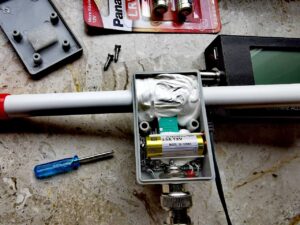
Staging a fake battery change on the AFA200C for the picture – the 4 months old supplied battery will likely last another 4 months!
First tests with the AFA200C
As soon as I got the antenna, I drove out to the dike to (quite literally) give it a whirl with my IC-705, since my new Belka was away for repairs. Again I brought the D-808 for a reference radio but this left me without much of a clue about the performance of the antenna because it was miles above the D-808. Of course it was, what was I thinking? It was obviously also cold and windy (sorry for the noises!):
Pocket-size transatlantic DX!
It was late December when I got the Belka back and the “mid-winter anomaly” seemed to have fully kicked in, so chances for transatlantic DX were rather slim. Yet I could hear some traffic report from 1010 WINS, 1130 WBBR [2] peaked up enough for ID’ing a few times and some murmur was heard from (likely) 590 VOCM on a nightly walk. Nothing spectacular under normal circumstances but given the bad time in the season and the minuscule equipment… On a second walk with the AFA200C, at an even more unearthly hour (4:00am local) in the freezing cold 8 weeks later I could also faintly hear 1030 WBZ, WXKS 1200, and (new one!) WBT 1110 from NC.
No recordings, sorry, most of the signals I got were nothing to phone home about yet — I just wanted to see if it’s worth the hassle at all, but “transatlantic MW DX on walks” seems to be a thing!
Performance comparisons
When I could finally take the Belka, the AFA200C and the CCRadio 2E to the dike for a proper daytime sensitivity test, it turned out that the combination of Belka and the AFA200C couldn’t always match the sensitivity of the CCrane 2E. With a few exceptions the AFA200C turned out a bit noisier, but there was no station to find that couldn’t be picked up by both radios.
Each of the following clips starts with the CCRadio 2E and switches radios every 5 seconds. Lets start with a stronger station that many portable radios strangely struggled to hear in past comparisons:
1449kHz BBC 4 Radio Scotland, Redmoss 2kW transmitter, 763km (474mi)
Here’s an example where the AFA200C/Belka could score maybe a hair better than the C.Crane:
810kHz BBC Scotland Network Westerglen/Burghead 100kW, 826km (513mi)
I’d say it’s a tie on the following one: Hungary is not really strong at this time of day, with the signal coming from the land side and not enjoying that salt water enhancement, but that day it was particularly bad. The modulation may not be intelligible on both [1] even if I could understand the language:
540kHz, Kossuth Radio, Solt, Hungary, 2Megawatts, 1090km/677mi
Here are 2 stations sharing the same frequency: I first recorded BBC 4 coming in from a weak transmitter in northeastern England, then turned the antenna to the southwest for Smooth Radio from an equally weak transmitter in Kent. The nulls are not overly sharp or deep on both radios, but they sure help disentangling the mess a bit:
603kHz, BBC 4, Newcastle-upon-Tyne, 500W, 677km (420mi)
603kHz Smooth Radio, Littlebourne (Kent), 400W, 607km (377mi)
Here’s Panjab Radio from the Crystal Palace Park in London. This recording will be important a second time soon:
558kHz, Panjab Radio, Crystal Palace (London), 2.5kW, 671km (417mi)
On very weak stations the CCRadio 2E is somewhat handicapped by its tuner and the AGC resulting in very low audio levels and also that odd “rice crispies” effect gnawing much off the better SNR of the CCR2E. Since I was using the fixed-level line-out of the CCRadio for the recording I couldn’t even crank the volume. The Belka has the AGC range to pull up the gain enough to achieve full audio level in all situations. I matched the levels when cutting the clips where necessary but here are two examples where I didn’t to give you an impression:
1602kHz, Radio Flandria. Hemelum, NL, 100W, 265km (164mi)
1413kHz Premier Christian Radio, Heathrow/Dartfort Marshes 500W, 650km (404mi)
Another very grassroots station that day (I suspect the tide having a word in this):
837kHz, BBC Asian Network, Leicester, 700W, 680km (422mi)
Whipping it all into relation
While I had the right radios on the picnic table, I was curious how well the Belka’s puny whip would compare to the CCRadio 2E and the AFA200C of course. The result was twofold surprising – the sensitivity was almost on par with the AFA200C and therefore not as far away from the CCRadio as I thought. During daytime, the whip’s lack of directivity isn’t even much of an issue (at least not on my spot of the globe), so this is good news! Compare this to the Panjab Radio recording above:
558kHz, Panjab Radio, Crystal Palace (London), 2.5kW, 671km (417mi)
Here’s once again the Westerglen (?) transmitter – the vertically polarized whip is less affected by the fading:
810kHz BBC Scotland Network, 100kW, 826km (513mi)
BBC 4 on 603kHz again but with the whip – same difference as the other recording with the AFA200C. The whip is making fun of me by picking up less of Smooth Radio than the CCRadio 2E:
603kHz, BBC 4, Newcastle-upon-Tyne, 500W, 677km (420mi)
Now that I have this comparison to the 5-star MW benchmark CCRadio 2E, I guess I need to correct my careful initial assessment (“3-3.5 stars”) of the Belka’s MW performance to “something ranging between 4 and 5 stars, it depends”. I find the results with both antennas very close to the CCRadio 2E and for a more precise ranking I’d need a known 4-star radio.
At any rate, I didn’t expect that the Belka is such a good MW performer on the whip! The AFA200C was not in all cases struggling to improve upon the whip, but at least during daytime it’s not essential for some MW DX fun with the Belka. But back to the AFA200C:
Downsides and other trouble
1. The entire tuning range is using little more than one half of the tuning knob travel. That makes maximizing the signal a needlessly fiddly affair challenging my motor skills, particularly because there is also some play in the pot.
2. The antenna is tuned slightly above 500 kHz (not 500kHz) at the left stop of the tuning knob and the tuning range ends at ~2200kHz (not 2500kHz) on knob position 6.
That the Q of the antenna is going from “very high” (narrow) on the low end to “very low” (wide) on the high side of the coverage range as seen in the video is to be expected. Still, the resonance peak is neither reaching 500kHz nor 2500kHz. Since it is obviously possible to make the antenna work within an (within wide limits) arbitrary frequency range, I would’ve expected more.
3. Maybe not an issue of this particular antenna but ferrite antennas, while counting as magnetic “H-field probes”, cannot be directly compared to small magnetic loops in terms of noise: When I received the AFA200C, my new Belka had just been sent off to Alex for repairs, so I connected it in place (using the same coax) of the YouLoop I have in my shack, connected to the IC-705 – with devastatingly bad results: The AFA200C picked up almost exclusively noise creeping up to the antenna via the coax, noise that the YouLoop barely registers. It only worked like the regular, internal loopsticks in my other radios when I connected the antenna directly to the BNC antenna jack of the 705 and put that on the most distant window sill. As soon as I got it closer to my own RFI sources, it turned out more susceptible to them than the built-in loopsticks in the other radios. That felt strange, but then again it’s my first amplified, tuned ferrite antenna and maybe that’s just how they are.
4. Not a technical issue but communication with SV2CZF was difficult: I didn’t get a confirmation email for my order to begin with and it took a few inquiries and 2 weeks before the antenna got sent off to me. When I received it and asked whether or not the limited effective travel of the tuning knob and the tuner not reaching the specified frequencies are normal and to be expected or unintentional, I got put off until a later reply that never came. I simply stopped troubling the seller with emails (maybe there was a health problem or other hardship), but this left me with rather mixed feelings about presenting this antenna in an article, and I cannot unconditionally recommend purchasing one of those. At least not if you’re not the relaxed and patient type.
Summary and verdict
The surprising result of the tests leading to this post is that the Belka’s MW sensitivity on the whip is making an external antenna almost unnecessary….again! It’s getting so close to match one of the top performers on MW, even on the whip!
The AFA200C brings marginal further improvements in sensitivity/SNR and its main advantage is providing some bidirectionality, which is essential at least for nighttime reception. The Belka+AFA200C combination is also showing aptitude for some light nightly transoceanic MW DX, when you take it outside on a nightly walk in a low-noise environment. It is small and lightweight enough to keep the resulting contraption pocketable.
The antenna is not fully reaching its frequency coverage specification and tuning is made quite fiddly by the tuning knob using only 60% of its travel. The oddball battery type may sound off-putting to people who never owned an analog camera but given the very specific task of 1-2 hours of occasional MW DXing when the conditions call for that and a battery endurance of 65 hours it could last for months. If you do not need the “wearability” aspect and want more performance, it could be wiser to save the money towards the parts for an FSL or other high-performance antenna.
The AFA200B/C/D antennas can be had for currently ~78€/~$86 (excl. shipping) from SV2CZF’s online shop.
Footnotes:
[1] I think I have learned that even loopstick antennas appreciate some height: It’s actually pretty logical – they are horizontal antennas and the close ground is bending the lobes upwards. For example, when I wanted to see how much miles I can get during Jock Elliott’s MW challenge, I ambitiously climbed up the (8m/26ft) dike and started looking for weak stations on the low end of the band. By the time I reached 720kHz (about 30 seconds) I had enough from the spanking breeze up there and decided to continue in the car, with the AFA200C put on the car roof using the tiny BNC magmount. Gone was the reception on 720kHz!
The dikes at the German North Sea coast have a sand core covered with 6ft of cohesive, compacted dirt and their ground conductivity is likely on the low side, which explains why I never had any indication that it would matter on which side of the dike I am. Elevating the antenna 8 meters above the highly conductive marsh soil/shoreline by putting it on top of the dike does seem to have an effect on horizontally polarized antennas though. Since MW daytime ground waves follow the curvature of the earth, their incidence angle is very low, therefore a low lobe elevation angle is once again recommendable.
[2] In terms of sensitivity, the CCRadio 2E could easily do WBBR because that’s a true “split-channel” station on this side of the pond and I received that station indoors with the D-808 and even with a short CB rubber antenna on the Belka. But for most other stations like 1010 WINS, stable ECSS and narrower filters are indispensable, so the CCRadio 2E is not the best radio for transoceanic “split-frequency” DX.

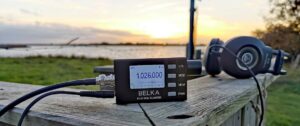
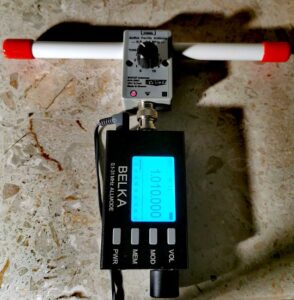
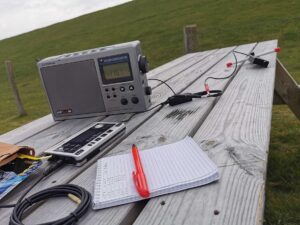
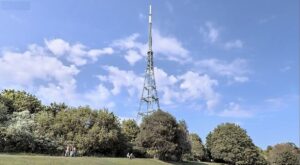
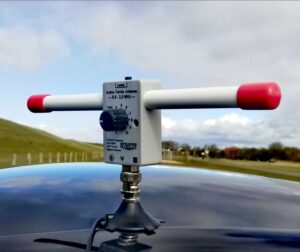
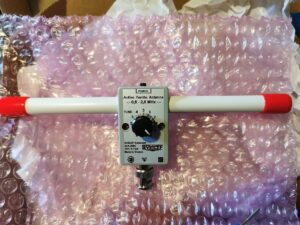
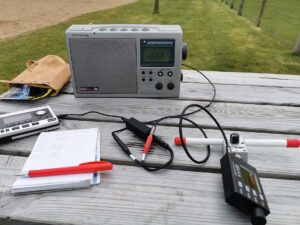
LOL – I love it! Thanks for the explanation 13dka 🙂
Thanks for the great review 13dka! Do you mind if I ask what repairs you had done on your new Belka?
Thank you, Sealord! The Belka had developed a problem due to (as it turned out) a solder joint gone bad. After some light remote diagnosis Alex asked me to send it back for repairs.
Now that happened in a time (around Xmas) when cargo transport between Germany and Belarus suffered severe delays so it took a while until it got there. The problem was then identified and fixed within 48 hours, but of course the Belka had the same trip in reverse ahead. I anticipated that and tried to mitigate that problem by ordering another one when I sent off the first one, but of course that meant having 2 Belkas simultaneously lying around on airports for 2 weeks, the sick one waiting in Germany for an airlift to Minsk and the other one in Belarus waiting for a plane to Frankfurt.
I’m currently in negotiations with Steven Spielberg about the movie rights but he doesn’t like that I insist on Tom Hanks playing Belka #1. Only if Tom is in, Leonardo DiCaprio is interested in playing the evil German customs officer who repeatedly ignored the value declaration on the CN22 slips and pushing DHL into a financial crisis by applying very arbitrary import taxes DHL had to pay in advance for me. Plot twist: They had to sell half of their cargo plane fleet for that, which is why the story unfolds in first place. Definitely a blockbuster! 🙂
73s,
Ollie
Another absolutely SUPERB review!
The Belka is another one of those radios that really hits a benchmark in so many regards (much like the IC-705). I, too, was surprised to hear how well it performed on the whip during your comparisons.
And, by the way, I love your 5 second toggled audio clips–they’re brilliant and just the right length of time to make it easy for your brain to examine audio characteristic of both.
It’s always a little Christmas gift when a 13dka post appears!
Thank you!
Thomas
Thank you, Thomas! You always find a way to make be blush (in a totally manly way of course)! 🙂
Ollie,
An excellent and interesting review!
Thanks for the hat tip on my review.
Cheers, Jock
Thank you, Jock! Credit where credit is due I’d say — you are creating a lot of quality content here!
73s,
Ollie
I was so excited to pick up a bunch of antennas but the lack of response or support killed the desire quickly.
I will keep the coins in my pocket for Dayton instead
Hi John,
I’m sure Dayton is a safe way to lose all coins you can pocket! I’m soooo glad that I don’t have any events like that around! 🙂 But seriously, one of the 2 bits of experience I gained as a customer is that every product is only as good as its support when things go bad. But then again, when hams turn their tinkering into a small business their support is more often than not outstanding but maybe it’s not something you can expect from them more than from any other, even big companies (which are usually not good at support either, to put it very, very friendly)? I don’t know, it’s the first time I had something like that. :/
73s,
Ollie
Beyond the overall performance issues with the antenna, I feel it is worth sharing my experience with the similar RFA200 passive antenna. I received one which has a tuning capacitor that is noisy at the top end of the frequency range (crackling noises transmitted to the receiver’s audio, sounding like a scratchy volume control). I have emailed Theo multiple times at all available addresses and never received a response of any kind.
Hi Mike,
Sorry to hear that! When you order stuff from far away and it’s not OK, that’s always a very unfortunate situation for everyone involved. Now a new tuning capacitor should not cause any effects like this and unless the plates touch each other or the cap loses contact to one plate package, it may not be the actual culprit. Investigating this is something the manufacturer should assist you with though!
Ollie
It’s an easy fix, if the capacitor is the open frame type. The ground returns that contact each end of the rotor are dirty. Push them toward the frame to expose where the channel cut in the shaft of the capacitor rotor and put a DROP of Cramolin or DeOxit in the rotor slot. Say g’bye to the static.
Thanks Chuck; however the type of capacitor is not immediately obvious as the entire assembly appears to be sealed; the ferrite rod and capacitor are part of a unibody plastic enclosure that might very well be glued or heat sealed closed. Owing to the size I’d suspect that it is open frame though; when I have time I will take a closer to look to see if it can be disassembled without too much damage.
Ollie,
Thank you for an interesting and informative review. I am amazed at your findings in comparing the Belka performance off the whip to the AFA200C.
I have ordered two passive antennas from SV2CZF and both work well. They both arrived promptly but there was no communication whatsoever. Reading your experiences with the tuning knob and the unusual battery have convinced me to pass on this loop antenna.
Ed
N4EJG
Thank you, Ed! What amazed me much more is that the Belka with its whip can hold a candle to the CCRadio 2E! That another 200mm tuned loopstick (the AFA200C) doesn’t have to be necessarily better than the 200mm loopstick in the CCR2E was something I absolutely expected, all I was hoping for is that it comes close, which it does. I don’t regret purchasing the AFA200C because the whip really stops working for anything but local stations after sunset, a loopstick antenna is the “minimum required equipment” then.
Ollie